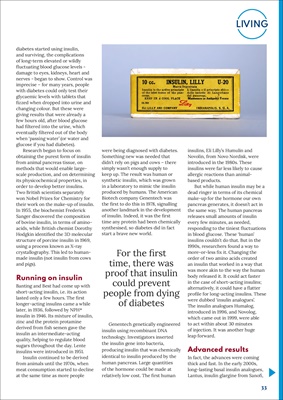
33
LIVING
diabetes started using insulin,
and surviving, the complications
of long-term elevated or wildly
fluctuating blood glucose levels -
damage to eyes, kidneys, heart and
nerves - began to show. Control was
imprecise - for many years, people
with diabetes could only test their
glycaemic levels with tablets that
fizzed when dropped into urine and
changing colour. But these were
giving results that were already a
few hours old, after blood glucose
had filtered into the urine, which
eventually filtered out of the body
when 'passing water' (or water and
glucose if you had diabetes).
Research began to focus on
obtaining the purest form of insulin
from animal pancreas tissue, on
methods that would enable largescale
production, and on determining
its physicochemical properties, in
order to develop better insulins.
Two British scientists separately
won Nobel Prizes for Chemistry for
their work on the make-up of insulin.
In 1955, the biochemist Frederick
Sanger discovered the composition
of bovine insulin, in terms of aminoacids, while British
chemist Dorothy
Hodgkin identified the 3D molecular
structure of porcine insulin in 1969,
using a process known as X-ray
crystallography. This led to humanmade insulin (not
insulin from cows
and pigs).
Running on insulin
Banting and Best had come up with
short-acting insulin, i.e. its action
lasted only a few hours. The first
longer-acting insulins came a while
later, in 1936, followed by NPH*
insulin in 1946. Its mixture of insulin,
zinc and the protein protamine
derived from fish semen gave the
insulin an intermediate-acting
quality, helping to regulate blood
sugars throughout the day. Lente
insulins were introduced in 1951.
Insulin continued to be derived
from animals until the 1970s, when
meat consumption started to decline
at the same time as more people
were being diagnosed with diabetes.
Something new was needed that
didn't rely on pigs and cows - there
simply wasn't enough supply to
keep up. The result was human or
synthetic insulin, which was grown
in a laboratory to mimic the insulin
produced by humans. The American
Biotech company Genentech was
the first to do this in 1978, signalling
another landmark in the development
of insulin. Indeed, it was the first
time any protein had been chemically
synthesised, so diabetes did in fact
start a brave new world.
insulins, Eli Lilly's Humulin and
Novolin, from Novo Nordisk, were
introduced in the 1980s. These
insulins were far less likely to cause
allergic reactions than animalbased
products.
But while human insulin may be a
dead ringer in terms of its chemical
make-up for the hormone our own
pancreas generates, it doesn't act in
the same way. The human pancreas
releases small amounts of insulin
every few minutes, as needed,
responding to the tiniest fluctuations
in blood glucose. These 'human'
insulins couldn't do that. But in the
1990s, researchers found a way to
more-or-less fix it. Changing the
order of two amino acids created
an insulin that worked in a way that
was more akin to the way the human
body released it. It could act faster
in the case of short-acting insulins;
alternatively, it could have a flatter
profile for long-acting insulins. These
were dubbed 'insulin analogues'.
The insulin analogues Humalog,
introduced in 1996, and Novolog,
which came out in 1999, were able
to act within about 30 minutes
of injection. It was another huge
leap forward.
Advanced results
In fact, the advances were coming
thick and fast. In the early 2000s,
long-lasting basal insulin analogues,
Lantus, insulin glargine from Sanofi,
For the first
time, there was
proof that insulin
could prevent
people from dying
of diabetes
Genentech genetically engineered
insulin using recombinant DNA
technology. Investigators inserted
the insulin gene into bacteria,
producing insulin that was chemically
identical to insulin produced by the
human pancreas. Large quantities
of the hormone could be made at
relatively low cost. The first human